Classics in the History
of Psychology
An internet resource developed by
Christopher D. Green
York University, Toronto, Ontario
(Return to Classics
index)
DICTIONARY OF
PHILOSOPHY AND PSYCHOLOGY
JAMES MARK BALDWIN (1901)
Definition - Brain
Brain [AS. bregen]: Ger. Gehirn,
Hirn (chiefly in compounds); Fr. cerveau encéphale;
Ital. encefalo, cervello (in broad sense). That part of the
central or axial nervous system which (in higher vertebrates) is enclosed
within the skull; the expanded cephalic portion of the neural tube, including
the centres or origin of the twelve cranial nerves, when present.
[This article consists of the following paragraphs: I. Historical; II.
Embryology; III. Anatomy; IV. Comparative Anatomy; and V. Functions. A
full bibliography of general works follows, and a glossary
is added supplying brief definitions of more important organs.]
I. HISTORICAL. -- That the brain is in some way connected with thought
was recognized very early, and this view prevailed among the Greek physicians
in spite of the fact that Aristotle described the brain as the most bloodless
and inert organ of the body. The Pythagoreans, Hippocrates, and Plato clearly
recognized the head as the seat of the intellect and will. Descartes was
the first to elaborate a consistent theory of brain functioning (cf. LOCALIZATION).
During the 17th century great advances were made in the purely anatomical
study of the brain, yet Leuwenhoeck was the first to employ the microscope
in its investigation. Reil introduced hardening and preservative processes.
Rolando and Stilling may be said to have founded the new technique by introducing
a method of preparing sections, though this process would have been relatively
fruitless but for Gerlach's discovery of the possibility of staining the
sections (cf. NEUROLOGY). Experimental neurology dates from Flourens, 1824;
but its fruition began in 1870 with Fritsch and Hitzig.
II. EMBRYOLOGY. -- [In this and the following sections free use should
be made of the glossary at the close of the article.] The brain, in common
with the entire nervous and sensory apparatus, arises from modifications
of the ectoderm. In higher animals the central nervous system appears as
a plate extending down the dorsal axis of the ectoderm, and it is very
early supplemented by accessory cephalic plates or bands composed of cells
which are to be employed in the elaboration of the higher organs of special
sense. The first stage in differentiation is the appearance of the medullary
groove, which soon deepens and becomes closed dorsally to form the neural
or medullary tube, out of whose substance the entire central nervous system
is plastically constructed. At or near the suture formed by the closing
of the neural tube arise the rudiments (Anlagen) of the sensory ganglia.
Cf. NERVOUS SYSTEM (Histogenesis), and Plate A (BRAIN).
The tube becomes inflated at three points toward the cephalic extremity,
thus forming three embryonic vesicles representing the primary fore-brain,
mid-brain, and hind-brain, respectively.
The cephalic vesicle soon evaginates on either side, forming pouches
(the primary optic vesicles) which project towards the skin, where they
meet the in-growing rudiments of the lenses. In the course of their being
moulded about the lens the original cavity is obliterated by the invagination
of the lateral aspects forming double walls, or the retina and pigment
layer of the choroid respectively. The cephalic portion of the primary
fore-brain also expands, and, in all but the lowest vertebrates, divides
into two hemispheres, whose ventricles remain connected by a median portion
(the aula) via two apertures (the portae).
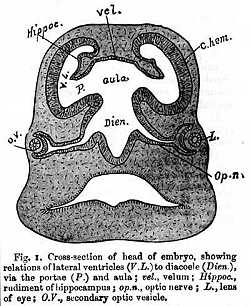
The second or mid-brain vesicle remains undivided, its roof forming
the optic tecta in which are situated the primary centres for vision. From
the dorsal aspect of the roof arise the four eminences, collectively constituting
the corpora quadrigemina. The base of this segment is largely occupied
by bands of fibres connecting higher regions with the medulla oblongata
and cord, and constitutes the crus. The cavity of the mid-brain (mesencephalon)
is gradually almost obliterated (in mammals), leaving only the aqueduct
of Sylvius.
The third vesicle subdivides to form the cephalic (metencephalic) and
caudal (myelencephalic) portion, the former being bounded by the pons and
isthmus region and cerebellum, and the latter by the walls of the medulla
oblongata proper. In this way the five most important divisions of the
brain are marked out.
Scarcely less important than the vesicles in the architectonic of the
brain are the flexures. The cephalic vesicle is flexed ventrad at an early
stage, making room for the dorsal growth of the hemispheres and producing
the cranial flexure. As though in compensation, the pons region is also
flexed ventrad, affording room for the cerebellum, and, at a still later
period, the cervical flexure marks the lower level of the medulla. By such
means the axis of the brain is crumpled to accommodate the inequalities
of growth.
As one result of these distortions, the actual cephalic terminus of
the neural tube is obscure. Comparative researches indicate that the tube
is, at an early stage, connected with the surface by a neuropore, whose
position is supposed to be in some point of the lamina terminalis. See
Plate A (NERVOUS SYSTEM).
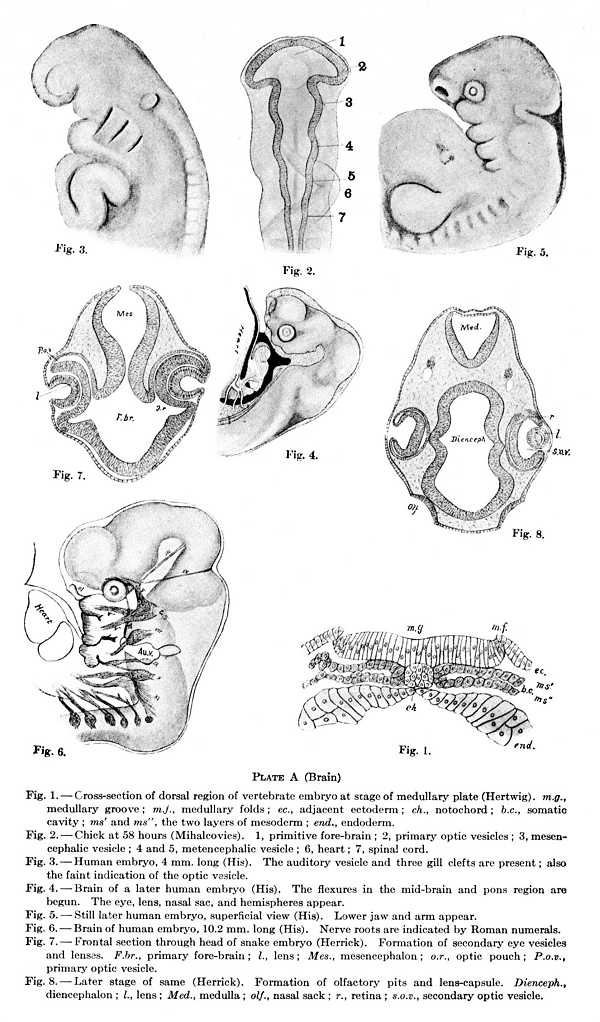
The two hemispheres are probably discrete from the first, being separate
evaginations from the primary fore-brain vesicle. In some cases they are
represented simply by solid thickenings of the walls of the vesicle. In
other cases the roof of the two hemispheres expands to form the mantle
or pallium, which is at first membranous, and this, in turn, produces the
dorsal walls of the cerebral hemispheres and their cortex, as well as a
vascular membrane which, under the name of paraplexus and preplexus (plexus
choroideus anterior), is folded into the cavities.
From this secondary fore-brain (prosencephalon) an evagination is thrust
out from the ventro-cephalic extremity of each hemisphere to form the olfactory
bulbs (containing the rhinocoele), and, after receiving accretions from
the olfactory mucous membrane, these form the first central stations of
the olfactory nerves. These, and the stalk connecting them with the hemispheres
(crura), and the eminence in which they are inserted (lobi olf.), together
with the entire median and ventral parts of the cerebrum, including the
hippocampus and part of the gyrus fornicatus of higher brains, have been
grouped together as rhinencephalon, from their association with the olfactory
function.
The median unaltered part of the primary fore-brain becomes the diencephalon,
including the thalamus and its appendages. The cavity is reduced to a narrow
slit (the third ventricle or diacoele). This extends ventrally into the
infundibulum and optic recesses.
Within the walls of the diencephalon there arise a variety of nuclei
of great importance in the physiology of the brain. Of these the mammillaria
are associated with smell, the geniculata with vision, and the subthalmicus,
and perhaps the ruber, with general and somatic sensation.
The second embryonic vesicle is less profoundly modified, though its
ventral aspect is largely reinforced by fibres to and from the higher regions,
thus forming the pes pedunculi.
The metencephalon and myelencephalon are formed from the walls of the
third vesicle, which collectively constitute the rhombencephalon. The roof
of the entire region is primarily membranous (tela-form), and so remains
in some lower animals. It is partly transformed into a complicated plexiform
organ which, with outgrowths of the pia, constitutes the metaplexus. In
various portions of the rhombencephalon lateral outgrowths of cellular
matter encroach upon the roof, forming more or less complete roofs over
the fourth ventricle. The most constant of these outgrowths is the cerebellum
or epencephalon. The cellular materials of which the cerebellum is largely
composed arise from rudiments in the lateral walls of the tube, and are
pushed dorsad, forming two lateral hemispheres which coalesce dorsally,
though a centre of proliferation also exists at the caudal extremity. See
NERVOUS SYSTEM (Histogenesis).
A special group of nuclei (n. dentatum, &c.) is developed in the
ventral aspects of the cerebellum by proliferations of ventricular epithelium,
and similar bodies (the olives) are formed by diverticles of ventricular
epithelium in the base of the medulla oblongata. The floor of the medulla,
otherwise, is largely occupied with fibres from the myelon and the root
nuclei of the cranial nerves, whose development obeys similar laws to those
of the cord.
The entire length of the brain has been laid off into embryonic zones,
each with its intrinsic peculiarities. (1) The basal plate, occupying the
ventral median line; (2) laterally the fundamental plates, containing the
root zones of the motor nerves; (3) alar plates, with the root zones of
the sensory nerves; (4) dorsal plate forming the roof. (1) and (4) are
primarily membranous and, as the most conservative portions of the nerve-tube,
are especially valuable in determining relationships. Cf. NERVOUS SYSTEM
(Comparative Anatomy).
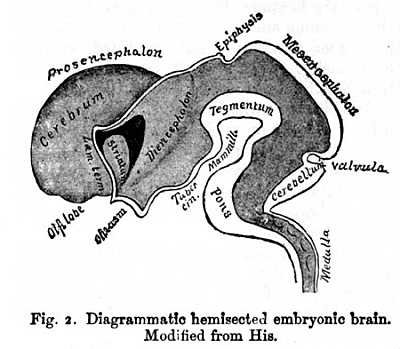
III. ANATOMY. Recalling the fact that all the structures of the adult
brain are derived from plicated and thickened modifications of the medullary
tube, the essential relations are best seen in a hemisection of the entire
brain, especially that of an embryo. See Fig. 2; cf. also Plate A (NERVOUS
SYSTEM).
In the adult the front of the original forebrain (lamina terminalis)
occupies a position well toward the middle of the brain. Ventrally it terminates
in the recessus preopticus, cephalad of the chiasm.
The two great prosencephalic commissures originally lie in the lamina
terminalis, though this relation is obscured in adult life. Of these commissures
the ventral one (precommisure) connects the ventral portion of the prosencephalon,
while the dorsal one (callosum) is the commissure of the pallium proper.
The great arch which this commissure makes over the portae and aula leaves
a space closed only by the thin septum lucidum. The membranous part of
the roof next following is the invaginated vascular preplexus; then the
evaginated preparaphysis and the velum, finally the post-paraphysis (Zirbelpolster)
and the supra-commissure.
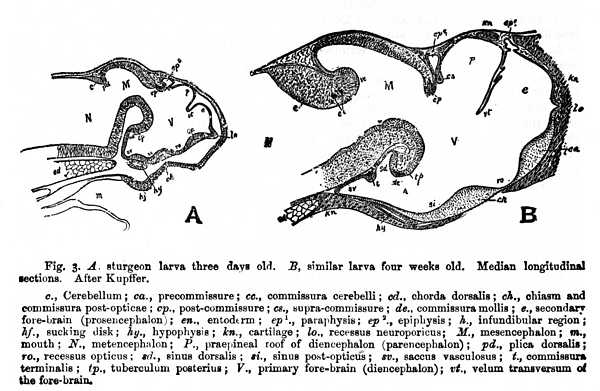
In the higher brains the mesal and caudal part of the hemispheres, viz.
the hippocampal region with its olfactory centres, is connected with its
fellow of the opposite side and the base of the thalamus by a transverse
band (the hippocampal or fornix commissure). In man the fornix is appressed
upon the callosum lying ventrad of it, but leaving a triangular interval,
the lyra Davidis. The corpus fornicis receives fibre bands (crura) from
the hippocampus, and sends others (columnae) towards the mammillaries.
The roof behind the supra-commissure is produced dorsad to form an organ
of variable size and structure which, in lower animals, stands in intimate
relation with a median PARIETAL ORGAN (q.v.). This epiphysis (sensu stricto)
is vascular, membranous, or absorbed in various groups. Near the point
where the epiphysis unites with the roof of the thalamus are the cellular
habenulae with their commissure. Then follows (passing caudad) the short
lamina intercalaris and the post-commissure at the cephalic limit of the
mesencephalon.
The ventral aspect of the thalamus exhibits the post-optic recess, infundibulum,
and mammillary recess; while a vascular outgrowth from a point caudad of
the infundibulum occurs in various aquatic animals, and constitutes the
saccus vasculosus. These are all diverticula of the third ventricule. The
mammillaries are cellular masses caudad of the tuber cinereum (see Glossary),
and are end-stations for the fornix fibre columns. The ventral part of
the thalamus, or hypothalamus, contains at least four commissures beside
the chiasm of the optic nerves.
The floor of the mesencephalon is composed of the massive pes pedunculi,
a strong tract of motor fibres from the cortex to the pyramidal tracts
of the spinal cord. This is the chief efferent path from the brain to the
trunk. Lying dorsally of it is the tegmentum. It contains the afferent
nuclei (ruber and niger), whose relations seem to be with the motor systems
especially, serving as shunting stations for the cerebellum. The tegmentum
also contains the lemniscus fibres, which are the great conductors of sensory
impressions to the brain. They associate the sensory nerve roots of the
medulla oblongata and cord with the caudal portion of the mesencephalon
roof. The dorsal walls of the mesencephalon contain optic centres (tectum,
&c.), as well as stations for the communication with the co-ordinating
motor nuclei; and, accordingly, in the caudal portions lie the nuclei of
the third and fourth nerves.
The medulla oblongata and cerebellum constitute a single region (rhombencephalon).
The medulla oblongata is that part of the brain which forms the transition
to the spinal cord, and, accordingly, it departs less than the rest of
the brain from the type of structure exhibited by it. The embryonic third
vesicle is greatly enlarged to form the metacoele, and its roof is largely
membranous. In the massive part of the embryonic medulla oblongata there
may be distinguished a basal plate, two fundamental plates, and two alae.
It is by complications and proliferations from the epithelium of the latter
that the lateral and dorsal outgrowths, including the olives (His) and
the cerebellum (Herrick), are developed.
Ventrally the surface exhibits the ventral columns and pyramids which
are crossed transversely by the pons fibres from the middle cerebellar
peduncle and the trapezoides fibres from the roots of the eighth nerve.
Dorsally, after removing the cerebellum, the dorsal columns (funiculi gracilis
et cuneatus) of each side unite to form the restiformia, and these pass
into the post-peduncles of the cerebellum. The dorsal fibres of the cord
(Goll's and Burdach's columns) terminate in the nuclei of the funiculi
gracilis et cuneatus, and are continued cephalad into the lemniscus by
bundles arising in these cell clusters. These soon decussate and take their
place in the ventro-lateral region laterally from the pyramid fibres, which
also cross at this level. This more or less continuous decussation in the
medial line forms the raphe.
We may follow this general review by a more detailed description of
the major divisions.
Cerebrum. In the development, after separation of the hemispheres,
a thickening in the base of each projects into the ventricle and constitutes
the striatum, an intermediary station through which pass nearly all the
fibres connecting the cortex with lower parts of the system. The striatum
is divided by the fibres of the corona radiata or internal capsule into
the nucleus lentiformis and the n. caudatus, each with subordinate portions.
As the development proceeds the hemispheres become flexed about an axis
terminating in the fossa Sylvii of either side, and the result of this
and analogous alterations is expressed by dividing the external aspect
into lobes (l. frontalis, parietalis, occipitalis, temporalis, insula,
&c.). The internal concomitant of this process is expressed by the
subdivision of the lateral ventricles into the cephalic, caudal, and ventral
cornua. At the same time the rapid expansion of the surface, due to formation
of the cortex, results in irregularities of the cortex constituting gyri
or convolutions separated by fissures or sulci. The most mesal and caudal
portion of the cortex is strongly conduplicated, forming a reverse curve
in section, and giving rise to the hippocampal region or cornu Ammonis,
with the gyrus hippocampi, whose section is S-shaped, and the gyrus uncinatus,
which is folded in the reverse sense into the inner limb of the S. The
fibres collected on the ventricular aspect of this region form the alveus,
while the tangential ectal fibres pass through the fimbria into the fornix.
See Fig. 4.
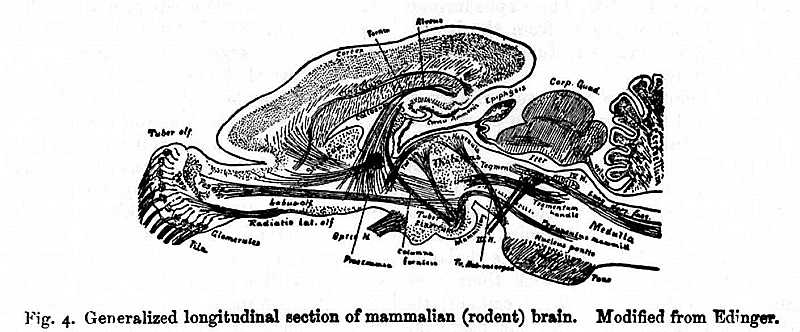
The transection in Plate B (BRAIN), Fig. 1 conveys a good idea of the
general relations. The topography of the cortex may be gathered from Figs.
5, 6, and 7. Cf. LOCALIZATION (cerebral).
The superficial layer of grey matter of the cerebrum, containing the
highest centres for sensation and voluntary motion (cortex in strict sense),
is usually regarded also as the seat of consciousness. Ontogenetically
the cortex is derived from the pallium, and includes the outer cellular
part as contrasted with the inner fibrous parts of the hemisphere's walls.
In the ventral and mesal regions the cortical layers merge into ventricular
grey matter, with which they have a common origin from the proliferating
ventricular epithelium.
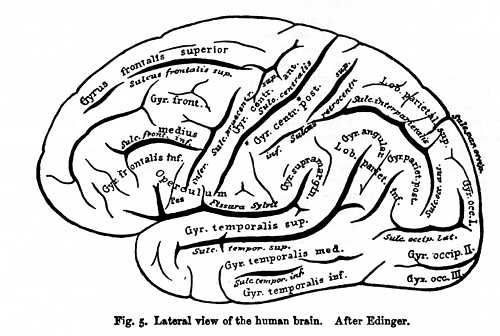
Although the arrangement and distribution of cortical elements varies
in different regions, they may be conveniently included in four layers
outside of the white matter. The most superficial zone is sparsely provided
with cells in which ramify the dendrites of the deeper nerve cells. In
this layer also originate the tangential fibres connecting with other regions.
This is the tangential fibre zone (also molecular, neuroglia, or Cajal-cell
layer). The second layer is filled with small pyramidal cells, which tend
to increase in size in deeper portions, forming a transition to the third
later of large pyramids. Beneath the latter is a zone of variously placed
polymorphic cells.
The relations between the cells of these layers are seen in Plate B
(BRAIN), Fig. 2. The pyramidal cells give rise to strong neurites, which
extend into projection-tract fibres and which occasionally give off strong
collaterals, passing via the callosum to homologous regions of the opposite
hemisphere. Other cells send their neurites into the tangential zone outward:
see ASSOCIATION FIBRES.
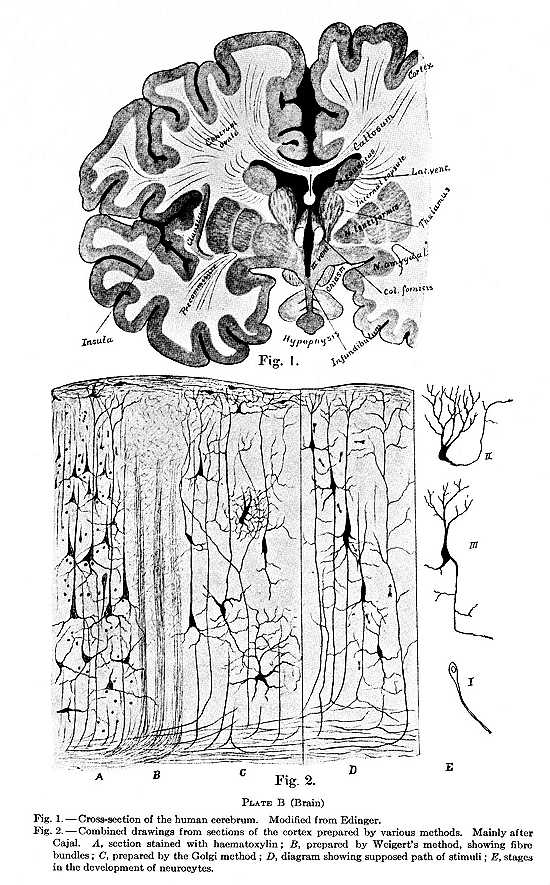
The framework of the cortex is originally supplied by the spongioblasts
of the endyma (see NERVOUS SYSTEM, Histogenesis), and, in the adults of
the lower animals, these cells continue to span the entire thickness of
the cortex. In the massive cerebrum of higher animals the so-called neuroglia
cells supplement the primitive spongioblastic framework.
The neurites of the cortical cells destined to the lower centres, collecting
in the corona radiata, and afterwards constituting the internal capsule,
are there segregated somewhat in accordance with their sources; and, accordingly,
various parts of the capsule contain fibres with different functions. See
LOCALIZATION.
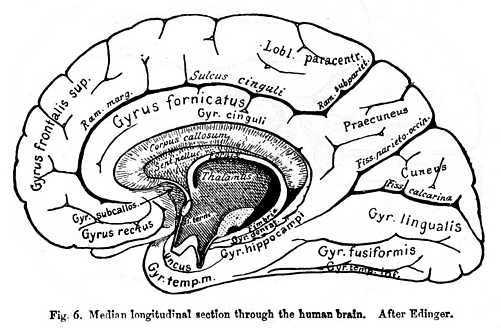
The speech centre (Broca's region) contributes a special tract to the
pyramids. The parietal motor zones are also represented by more or less
distinct bands in the internal capsule. The optic radiations connect the
optic centres of the thalamus with the occipital cortex, and it is probable
that each sensory area has its reflex tract connecting with the appropriate
lower centres. Special tracts from the striatum pass to the tegmental nuclei.
Cerebellum. Although derived from outgrowths of the lateral walls
of the metacoele, the cerebellum in mammals consists of a median vermis
and two lateral hemispheres, with two or more smaller paired bodies (flocculi).
The surface is marked by convolutions and depressions analogous to the
gyri and fissures of the cerebrum. The cortex of the cerebellum (Fig. 8)
is extraordinarily complex, and beautifully illustrates the apparatus for
nervous discharge by contiguity rather than by structure continuity. Three
layers may be distinguished above the white fibre zone. Of these the middle
layer, composed of the cells of Purkinje, is most important. These large
pyramidal cells are in a single layer, and their very numerous dendrites
ramify in mazy arborizations within the ectal or molecular layer (Fig.
9). The neurites from the bases of the cells of Purkinje pass in regular
order into the ental white layer, but give off, in their course, numerous
collaterals which enter into close relations with other similar cells.
In the ectal layer, or zona molecularis, the dendrites of the Purkinje
cells are intimately associated with the terminal ramifications of the
scandent fibres, which, arising in unknown (probably extra-cerebellar)
cells, ascend between the Purkinje cells and ramify among their dendrites.
Other cells within the molecular layer give off tangential fibres, from
which arise collaterals which descend and surround with their fine ramifications
the bodies of the Purkinje cells, thus effecting a co-ordination with the
latter. Beneath the Purkinje layer is the zona granulosa, composed essentially
of small polygonal cells having large nuclei whose dendrites soon subdivide,
while their neurites enter into the molecular layer and there bifurcate.
Other cells of the grandular layer resemble the cells of Purkinje, but
their neurites ramify in the same layer.
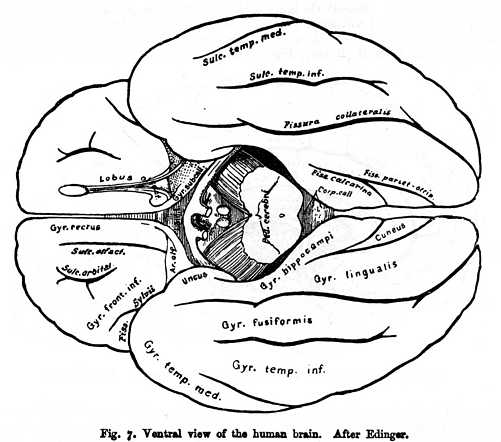
The external connections of these cells are problematical. Of the three
pairs of cerebellar peduncles, the cephalic pair (superior brachia) connect
the cerebellum with the tegmental nuclei and with Gower's ascending tract
of the spinal cord. The middle peduncles consist, chiefly at least, of
fibres from the pons, which pass to the lateral cerebellar hemispheres
(pilea). These fibres are in part neurites from the Purkinje cells of the
cerebellar cortex, terminating about the cells of the nuclei pontis of
the same and the opposite side, and also going an unknown distance cephalad
in the pyramids; in part they are neurites of the cells of the nuclei pontis,
terminating probably as the scandent fibres of the molecular zone of the
cerebellar cortex. The cells of the nuclei pontis are in communication
not only with the terminal arborizations of the Purkinje cells, but with
collaterals from the underlying pyramidal fibres. We clearly have here
provision for both ascending and descending fibres connecting the cerebellar
cortex with the great motor and sensory tracts leading down from the cerebral
cortex. The caudal peduncles enter the corpora restiformia and contain
fibres to the fleece and vermis. They receive the ascending direct cerebellar
tract of the spinal cord, fibres from the great lemniscus system (nuclei
funiculi gracilis et cuneatus), and, directly or indirectly, fibres from
the auditory nerve, and others less thoroughly known.
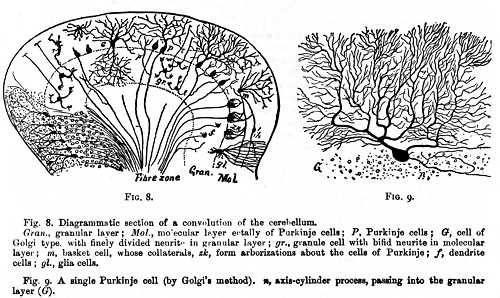
The Membranes (meninges). The membranous envelopes of
the central nervous system are three in number, the innermost or pia belonging
strictly to the nervous organ, while the outer one, the dura, is more closely
associated with the bony walls. The middle membrane, or arachnoid, is variable
in its relations. Sometimes the outer envelope is called pachymenix, and
the inner leptomenix, though these terms appear more often in combinations,
such as pachymeningitis. The dura within the cranium is apparently simple,
but within the spinal cavity it is cleft into an inner layer, or theca,
and an outer one closely attached to the vertebrae. The interval between
these is the epidural space. The space between the cerebellum and cerebrum
is occupied by a fold of dura (sometimes ossified) constituting the tentorium.
>From the middle of the tentorium a similar fold extends between the two
cerebral hemispheres dorsally of the callosum, forming the falx and enclosing
the great longitudinal blood sinus. The membranes are subject to various
diseases, often of a serious character. Leptomeningitis is a purulent inflammation
of the pia and adjacent parts of the brain. It is an infectious and often
epidemic disease due to a diplococcus. Primary meningitis originates at
the base of the brain; minute hemorrhages in the brain substance and distension
of the ventricles are frequent concomitants. The prognosis is grave, and
recovery in any event usually but partial. Tubercular meningitis is apparently
due to infection from other organs. Pachymeningitis is an inflammation
of the dura, and is an accompaniment of various diseases, especially chronic
diseases of the brain itself. The meninges are freely supplied with sensory
cerebro-spinal and vaso-motor sympathetic nerves.
Circulation in the Brain. The circulation within the brain is
chiefly provided for by the vessels of the meninges, and those of the intrusions
of the brain walls forming apparently intra-ventricular plexuses. Although
Mendel has found that the pressure in the cortical arteries is less than
that in the carotids, it is true that any serious alteration in the vascular
pressure is attended with functional disturbance. The intra-cranial arteries
fall into two systems. (1) The meningeal, or dural, which ramify upon the
dura and diploi of the cranium. Nearly the whole dura is supplied by branches
of the external carotid, of which the medi-dural is the largest. The internal
carotid supplies the hypophysis and Gasser's ganglion. The vertebral gives
rise to the post-dural, which supplies the dura of the postcranial fossa,
especially the falx. (2) Intrinsic arteries are such as supply the brain
substance. Four arteries supply this system, the paired carotids and the
vertebrals. These primary vessels combine to form the circle of Willis
in the brain base, and from this polygonal vessel arise all the cerebral
arteries. Intra-vascular pressure is less in the grey than in the white
matter. The veins likewise are divided into dural and intrinsic veins,
and all of the dural and most of the intrinsic veins open into sinuses
or spaces with non-collapsible walls. The largest sinus is the longitudinal,
parallel to the sagitall suture, and is the vessel presenting most difficulty
to intra-cranial operation. The lymphatic system of the brain, though obscure,
is not wholly absent. Its most rudimentary form is seen in the peri-cellular
spaces. The lymph canals collect and pass out in company with the veins.
The endyma and hypophysis are closely associated with the lymph-vascular
systems.
IV. FUNCTIONS OF THE BRAIN. Two general theories of brain function may
be distinguished. According to the earlier, more mechanical theory, the
brain is a collection of different organs which, while more or less connected
serially by nervous paths, are nevertheless distinct in nature and function.
This anatomical survey of the psychological concept of discrete faculties
received strong support from the data of localization, although there have
always been advocates of the doctrine of cerebral unity. Modern histological
researches have reinforced the argument for the essential unity of the
brain by showing that not only are all parts derived from the homogeneous
brain-tube, but that the cellular elements have a homologous origin from
the ventricular epithelium. Furthermore, the discovery of communication
by contiguity rather than actual continuity of structure, indicates that
the intercommunication may be much more complicated and extensive than
was formerly supposed possible. The vast complexity of the fibrous processes
from the various cells, and the systems of collaterals and association
fibres, reveal in the brain a degree of solidarity inconsistent with a
rigid localization. The conditions seen in brains of Amphibia, where an
almost undifferentiated zone of cells adjacent to the ventricles serves
for all the various and diverse functions, and where chains of associated
cells mark the course of tracts of the highest importance, forcibly impress
the idea that it is rather the relations than the structure of the cells
which determine the function, and that the nervous or physical resultant
is, in a sense, the algebraic sum of the activities -- an equation of function.
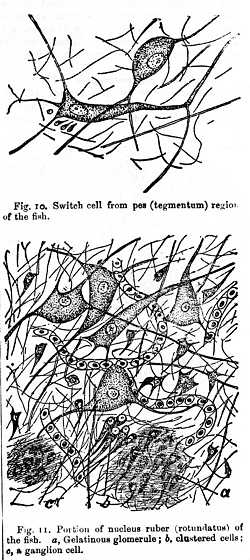
The neurocytes may be roughly classed as centripetal, centrifugal,
and intercalary, with respect to the central organ or stations; though,
strickly speaking, each neurocyte is simply a node in a path, the cellipetal
parts being dendrites; the cellifugal, the neurite. The third class seems
to serve to divide a tract or to switch stimuli from the direct to an indirect
route, as in the tegmental nuclei. See Figs. 9, 10, 11.
There is much reason to believe that within, as well as outside the
central system, many neurocytes may be merged in a single long circuit
or tract. In some cases the cell body is thrown out of circuit and remains
a mere appendage with a nutritive function only, while in others the impulse
passes through the cell, and is there probably reinforced or modified.
Good illustrations of the complicated paths pursued by a stimulus are afforded
by the special senses. For example, an irritation in the nasal epithelium
passes via a neurite, or from cell to cell to a neurite whose fine arborizations
enter a glomerule and communicate with one of the dendrites of one of the
mitral cells of the pero. See Fig. 6 (NERVOUS SYSTEM). Thence the stimulus
may pass via a neurite or chain of cells to the hippocampus, and there
a similar communication is effected with the dendrites of the long pyramids
of the hippocampal cortex, in the bodies of which we may suppose an excitation
is established, the effect of which upon the total equilibrium of the sensorium
constitutes a sensation of smell. But, at the same time, other neurites
convey stimuli via the fimbria and fornix to the thalamus, where reflex
associations of the most complicated sort are effected. In fact the whole
infra-cortical tone is perhaps modified, and profound changes in circulation
and the relative receptivity of various sense organs may result. Nor are
these sub-conscious changes devoid of their secondary influence on consciousness.
The theory of consciousness which seems best to conform to the conditions
of brain structure and its observed unity is that each conscious state
is an expression of the total equilibrium of the conscious mechanism, and
that intercurrent stimuli are continually shifting the equilibrium from
one to another class of activities. In other words, the sensation accompanying
a given colour presentation is not due to the vibrations in the visual
centre in the occipital lobe, but to the state of cortical equilibrium
or the equation of cortical excitement when that colour stimulus predominates.
Previous vestigal excitements and co-ordinations with the data from other
cortical centres all enter into the conscious presentation. As the wave
of excitation passes from the visual centre to other parts, the proportional
participation of other centres increases, producing a composite containing
more distantly related elements.
What the exact nature of the infra-conscious processes in the thalamus,
&c., is, may never become wholly clear. The stimuli from the organ
of sense are said to be organized for presentation to the cortical centres.
A very important function also is the proper provision for the complex
reflex co-ordinations. Removal of any centre or area impairs the equilibrium,
and so, aside from suppressing the function of the destroyed organ, alters
the 'tone' of the consciousness.
The existence of non-functioning cells or portions from which new neurocytes
may develop on occasion, is rendered probable by the data of histogenesis
and by the occurrence of functional substitution.
That the cerebellum does not participate in the psychical, emotional,
or generative functions has been made probable by recent experiments. That
it has no direct relation to the fifth or eighth nerve roots seems likely,
although some connection with the vestibular apparatus is conceded.
The direct effect of injury to or disease of the entire cerebellum is
disturbance of motor equilibrium and co-ordination evidenced by imperfect
station and locomotion without notable reduction of motor power. Astasia,
or unsteadiness of head, trunk, and limbs, is permanent. Injury confined
to the median lobe produces similar symptoms, but less pronounced, while
unilateral injury affects the equilibration of the same side. Section of
the peduncles of one side produces essentially the same effects as destruction
of the corresponding lateral lobe of the cerebellum. Section of the middle
peduncles results in atrophy of the nucleus pontis of the opposite side
and the connecting pons fibres. There is evidence that removal of one half
of the cerebellum increases the excitability of the opposite cerebral hemisphere.
The medulla oblongata participates largely in the reflex functions of
the spinal cord, but is pre-eminently the locus of the primary centres
of special sense. Here, too, the centres of the vagus nerve provide for
vital co-ordinations. The term 'vital node,' though perhaps an anatomical
fiction, expresses the intimate co-ordinations between the centres for
vascular, respiratory, and digestive functions in centres immediately adjacent
to the floor of the metacoele. The psychical importance of these centres
lies in their intimate, though obscure, relation to the emotions. The anatomical
basis for this connection is, as yet wholly unknown.
For discussion of the phylogeny of the Brain, see NERVOUS SYSTEM.
V. COMPARATIVE ANATOMY. -- Comparisons of the human brain with that
of brutes are made in various ways, the relations of mere volume or weight
being untrustworthy. In general, it is obvious that the extent to which
consciousness has been interpolated in the cycle of nervous processes increases
as we ascend the scale. The area of cortex devoted to the immediate spheres
of the sense organs is surprisingly great in lower vertebrates. The lowest
of the special senses (smell) is found to occupy a relatively enormous
proportion of the cortex in reptilia, and even in marsupials such a disproportion
is conspicuous. It is only in higher mammals that a large proportion of
the cortex seems to have been reserved for correlations of higher orders.
The apparent absence of a callosum in marsupials, &c., has a morphological
rather than functional bearing, for the associational fibres proper to
the callosum pass via the precommissure. In the estimation of the position
of a brain type in the scale, use is made of certain indices. The occipital
and parietal indices are the distances along the mesal margin of the hemispheres
intercepted by the intersection of the external parieto-occipital fissure
and the central Rolandic fissure respectively, measuring from the occipital
pole in the first case, and from the occipito-parietal intersection in
the other; the measurements being in hundredths of the entire length along
the dorsal margin of the hemisphere. A table of such measurements is given
as follows: --
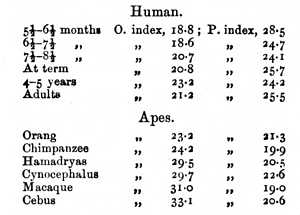
In low apes there is an enormous increase in the occipital portion of
the border, whereas in high apes the amount of increase is smaller. Only
Primates, which alone possess well-developed occipital lobes, exhibit transitory
fissures of the cerebrum. The cuneus in certain abnormal conditions of
the human brain resembles that of apes.
The insula is larger in the male than in the female, and in the European
than in lower races. In the relations of the insula and its opercula the
embryonic conditions in man resemble those of apes. Cf. INDEX (cephalic),
and ANTHROPOID.
Literature: Excellent literature lists will be found in SCHWALBE'S
Neurologie, in QUAIN'S Anatomy, in Amer. Textbook of Physiol. (Philadelphia,
1896), and in most of the other general works cited below. EDINGER'S Berichte
published in Schmidt's Jahrb. and MERKEL und BONNET'S Ergebnisse give comprehensive
annual summaries. L. F. BARKER, The Nerv. Syst. and its Constituent Neurones
(New York, 1899; 1122 pp., 683 figs.), is an excellent and comprehensive
digest of the literature, especially the most recent, on nerve-cells and
their relations.
H. C. BASTIAN, The Brain as an Organ of Mind (London, 1880); Über
das specifische Gewicht des Gehirns, Arch. f. Heilk. (1886). W. V. BECHTEREW,
Die Leitungsbahnen im Gehirn und Rückenmark (Leipzig, 1884). L. BIANCHI,
Functions of the Frontal Lobes, Brain, xviii (1895). TH. L. W. V. BISCHOFF,
Das Hirngewicht des Menschen (1880). E. BRISSAUD, Anatomie du cerveau de
l'homme (Paris, 1893). A. BROCA, Anatomie descriptive des circonvolutions
cérébrales, Gaz. hebdom., xxxviii (1891). T. E. CLARK, Comparative
Anatomy of the Insula, J. of Compar. Neurol., vi (1896). D. J. CUNNINGHAM,
The Complete Fissures of the Human Cerebrum and their Significance in connection
with the Growth of the Hemisphere, J. of Anat. and Physiol., xxiv (1890);
The Surface Anatomy of the Cerebral Hemispheres, Cunningham Mem. of the
Roy. Irish Soc., No. vii (1892). B. DAVIS, Contributions toward determining
the Weight of the Brain in different Races of Men, Philos. Trans. (1869).
C. DEBIERRE, Sur les anomalies des circonvolutions du cerveau de l'homme,
C. R. Soc. de Biol., iii (1891). DÉJERINE, Anatomie des centres
nerveux, i (Paris, 1895). H. H. DONALDSON, Anatomical Observations on the
Brain and Sense Organs of the Blind Deaf-mute Laura Bridgman, Amer. J.
of Psychol., iii, iv (1890-1); The Growth of the Brain (London and New
York, 1895). T. DWIGHT, Remarks on the Brain of a Distinguished Man, Proc.
Amer. Acad. Sci., xiii (1887). L. EDINGER, Vorlesungen über die nervösen
Centralorgane des Menschen und der Thiere, 5th ed. (1896, trans., 1899).
EXNER, Zur Kenntniss vom feineren Baue der Grosshirnrinde, Wien. Sitzungsb.,
III Abth., 1xxxiii (1881). FERRIER, The Functions of the Brain, 2nd ed.
(London, 1886). E. FLATAU, Atlas of the Human Brain and Description of
the Course of the Nerve Fibres, trans. by Nathan and Carslaw (Glasgow,
1894). P. FLECHSIG, Die Leitungsbahnen im Gehirne und Rückenmarke
des Menschen (Leipzig, 1876); Gehirn und Seele: Rectoratsrede (Leipzig,
1894). M. FOSTER, A Textbook of Physiol., 7th ed. (London and New York,
1891). GANSER, Gehirn des Maulwurfs, Morphol. Jahrb., vii (1882). A. V.
GEHUCHTEN, Anatomie du système nerveux de l'homme, 2nd ed. (Louvain,
1897). C. GOLGI, Untersuchungen über den feineren Bau des centralen
und peripherishchen Nervensystems, trans. from the Italian (Jena, 1894).
B. V. GUDDEN, Gesammelte und hinterlassene Abhandlungen (Wiesbaden, 1889).
D. J. HAMILTON, On the Corpus Callosum in the Adult Human Brain, J. of
Anat. and Physiol., xix (1885); On the Corpus Callosum in the Embryo, Brain,
viii (1885). H. HELD, Die centrale Gehörleitung, Arch. f. Anat. u.
Physiol. -- Anat. Abth. (1893); other papers on the medulla and the quadrigemina,
same periodical (1891-3), in Neurol. Centralbl. (1890), and in Abhandl.
d. kgl. sächs. Gesell. d. Wiss. (1892). J. HENLE, Handbuch der Nervenlehre
des Menschen, 2nd ed. (Braunschweig, 1879). HERMANN, Handb. d. Physiol.
(1879). C. L. HERRICK, Illustrations of the Architectonic of the Cerebellum,
J. of Compar. Neurol., i (1891), and The Histogenesis of the Cerebellum,
ibid., v (1895); numerous other papers in the same journal (1891-9). HERVÉ,
La circonvolution de Broca, Thèse (Paris, 1888). A. HILL, The Plan
of the Central Nervous System (Cambridge, 1885). W. HIS, Zur allgemeinen
Morphologie des Gehirns, Arch. f. Anat. u. Physiol. -- Anat. Abth. (1892).
S. HONEGGER, Vergleichendanatomische Untersuchungen über den Fornix
(Zürich, 1891). T. H. HUXLEY, On the Brain of Ateles paniscus, Proc.
Zool. Soc. (1861). A. V. KÖLLIKER, Handb. d. Gewebelehre des Menschen,
ii (Leipzig, 1896). W. KRAUSE, Über Gehirngewichte, Allg. Wien. med.
Zeit. (1888); and Int. Monatssch. f. Anat. u. Physiol., v (1888). LANGLEY
AND GRÜNBAUM, On the Degenerations resulting from Removal of the Cerebral
Cortex and Corpora Stiata in the Dog, J. of Physiol., xi (189?). LUYS,
Nouvelles recherches sur la structure du cerveau et l'agencement des fibres
blanches cérébrales: L'Encéphale (1884). J. MARSHALL,
Relations between the Weight of the Brain and its Parts and the Stature
and Mass of the Body in Man, J. of Anat. and Physiol., xxvi (1892); The
Brain of the late George Grote, with Comments and Observations on the Human
Brain and its Parts generally, J. of Anat. and Physiol., xxvii (1892).
TH. MEYNERT, Psychiatry, trans. by Sachs (1885); also art. Brain, in Stricker's
Histol. (1872); Das Gesammtgewicht und die Teilgewichte des Gehirnes, &c.,
Vtljsch. f. Psychol. (1867). G. MINGAZZINI, Il Cervello in relazione con
i Fenomeni psichici; Studio sulla Morfologia degli Emisferi cerebrali dell'
Uomo (Turin, 1895). MONAKOW, several works bearing especially on the optic
connections in Arch. f. Psychol. (1889, 1892, 1895). H. MUNK, Über
den Hund ohne Grosshirn, Arch. f. Anat. u. Physiol. -- Physiol. Abth. (1894).
H. OBERSTEINER, Anleitung beim Studium des Baues der nervösen Centralorgane
im gesunden und kranken Zustande, 3rd ed. (Leipzig, 1896), Eng. trans.
of earlier ed., Philadelphia (1890); Die neueren Forschungen auf dem Geblet
des Centralnervensystems, kritisch beleuchtet, Wien. med. Wochen., xlv
(1895). H. F. OSBORN, The Origin of the Corpus Callosum; a Contribution
upon the Cerebral Commissures of the Vertebrata, Morphol. Jahrb., xii (1887).
E. PUSATERI, Sulla fine Anatomia del Ponte di Varolio nell' Uomo, nota
prelim., Riv. di Patol. Nerv. e Ment., i (1896). A. RAUBER, Lehrb. d. Anat.
des Menschen, 4th ed., ii. Abth II (Leipzig, 1894). Reference Hand-Book
of the Medical Sciences, Wm. Wood & Co., articles by Browning, Wilder,
Spitzka, Baker, Herrick, and others. G. RETZIUS, Biol. Untersuch. (Stockholm,
1875-95); Atlas of the Brain. J. V. ROHON, Zur Anatomie der Hirnwindungen
bei den Primaten (München, 1884). H. SACHS, Vorträge über
den Bau und die Thätigkeit des Grosshirns (1894). E. A. SCHAEFER,
Spinal Cord and Brain, iii, Part I of Quain's Anatomy, 10th ed. (London
and New York, 1893). SCHIFF, Lehrb. d. Physiol. G. SCHWALBE, Lehrb. d.
Neurol. (Erlangen, 1881). SHERRINGTON, Nerve Tracts degenerating secondarily
to Lesions of the Cortex Cerebri, J. of Physiol., xi (1890); Further Note
on Degenerations following Lesions of the Cerebral Cortex, J. of Physiol.,
xi (1890). O. SNELL, Die Abhängigkeit des Hirngewichtes von dem Körpergewicht
und den geistigen Fähigkeiten, Arch. f. Psychiat., xxiii (1891); Das
Gewicht des Gehirnes, Münch. med. Wochensch. (1892). E. C. SPITZKA,
Architecture and Mechanism of the Brain, J. of Nerv. and Ment. Dis. (1878
f.). TOPINARD, Le Poids de l'Encéphale, Mém. Soc. de l'Anthropol.,
iii (1888). W. TURNER, The Convolutions of the Human Cerebrum (Edinburgh,
1866); The Convolutions of the Brain, Verh. d. int. Congresses (Berlin,
1890), ii, and J. of Anat. and Physiol., xxv (1890). VULPIAN, Leçons
sur la physiologie du système nerveux (Paris, 1866). W. WALDEYER,
Die Hirnwindungen des Menschen, Verh. d. int. Congresses (Berlin, 1890);
Das Gibbon-Hirn, Virchow-Festschrift, iii (1891). MAX WEBER, Vorstudien
über das Hirngewicht der Säugethiere, Festschrift f. Gegenbaur,
iii (Leipzig, 1896). CARL WEIGERT, Beiträge zur Kenntniss der normalen
menschlichen Neuroglia, Abh. d. Senckenberg'schen Naturf. -Ges. in Frankfurt
a. M., xix. I (1895). C. WERNICKE, Lehrb. d. Gehirnkrankheiten, i (1881);
Grundriss der Psychiatrie in klinischen Vorlesungen, Theil I, Psycho-physiologische
Einleitung (Leipzig, 1894). B. G. WILDER, The Outer Cerebral Fissures of
Mammalia, especially of the Carnivora, and the Limits of their Homologies,
Proc. Amer. Assoc., xxii (1873); On the Removal and Preservation of the
Human Brain, Trans. Amer. Neurol. Assoc. (1883); J. of Nerv. and Ment.
Dis., N.S., viii (1883); Methods of Studying the Brain, The 'Cartwright
Lectures' for 1884, N. Y. Med. J., xxxix-xl (1884); The Cerebral Fissures
of Two Philosophers, Chauncey Wright and James Edward Oliver, J. of Compar.
Neurol., v (1895) and J. of Nerv. and Ment. Dis., N.S., xx. (1895). W.
WUNDT, Gehirn und Seele, in 'Essays' (Leipzig, 1885); Grundzüge d.
physiol. Psychol. (4th ed.), Erster Bd., Erster Abs. (Leipzig, 1893).
GLOSSARY OF BRAIN ANATOMY.
[The cross-references in SMALL CAPITALS refer to other topics in the
Dictionary, those in Roman type to other terms in this glossary.]
Afterbrain. The medulla oblongata.
Ala Cinerea. The thin dorsal wall of the metacoele where it joins
the velum caudale.
Alar Plate. One of the regions of the medullary tube. The longitudinal
zone on either side near the base from which arise the sensory nerve roots.
Alveus. The fibrous layer of the ventricular surface of the gyrus
hippocampus.
Ammonshorn: see Hippocampus.
Ansa Lentiformis. Fibres from the putamen of the nucleus lentiformis
which, instead of passing through the internal capsule, pass near the brain
base on their way to the thalamus.
Ansa Peduncularis. Fibres forming an arch superficially to the
cerebral peduncles and ventrad of the nucleus lentiformis; the 'substantia
innominata.'
Aquaeductus Sylvii: see Iter.
Arachnoidea. The middle one of the three membranes investing
the brain. See BRAIN (Meninges).
Arbor Vitae. The peculiar ramose appearance presented by a section
of the cerebellum, which is due to the distribution of the white and grey
matter.
Area Olfactoria. The region on the ventral aspect of the hemispheres
through which the olfactory radiations pass on their way to the hippocampus.
Area Parolfactoria. The median aspect of the hemispheres cephalad
of the lamina terminalis and ventrad of the free cortex [Edinger].
Area Post-perforata: see Perforata.
Area Preperforata: see Perforata.
Aula. The remnant of the first embryonic vesicle which connects
the third ventricle by way of the portae with the lateral ventricles.
Axial Lobes. The solid masses of grey matter forming the massive
part of the hemispheres in some low vertebrates. They contain the homologues
of the striata and some additional undifferentiated structures.
Axis, Cerebro-spinal: see Neuraxis.
Basal Ganglia. The masses of grey matter below the cortex forming
the terminal stations of the lower projection systems. The corpora striata
[Edinger], or these bodies together with the nuclei of the thalamus [many
authors].
Basal Plate. One of the regions of the medullary tube. The longitudinal
zone forming the median ventral portion (primarily membranous).
Brachium Coniunctivum Cerebelli. The pre-peduncle. See Pedunculi
Cerebelli.
Brachium Inferius Cerebelli. The post-peduncle. See Pedunculi
Cerebelli.
Brachium Opticum. The central prolongation of the optic tracts,
together with fibres from the cortex.
Brachium Pontis. The medi-peduncle. See Pedunculi Cerebelli.
Brachium Quadrigeminum: see Brachium Opticum.
Brachium Superius Cerebelli. The pre-peduncle, See Pedunculi
Cerebelli.
Broca's Region. The cortical region near the Sylvian fissure
associated with the function of speech.
Bulb. The medulla oblongata, especially in compounds, as bulbar
paralysis; a term the use of which is not to be commended.
Bulbus Olfactorius. The protuberance from the hemisphere which
receives the olfactory 'nerve' (more properly radix: see Radix Olfactorius).
It consists of an external part, or pero, and an axial portion, the pes.
Burdach's Column. The more lateral of the two dorsal fibre columns
of the cord. In the medulla it becomes the funiculus cuneatus.
Calamus Scriptorius. The most caudal tip of the fourth ventricle.
Calcar [Avis]. A protuberance into the caudal cornu of the lateral
ventricle due to the invagination of the cortex in the region of the fissura
calcarina; the hippocampus minor.
Canalis Centralis. The remnant of the cavity of the medullary
tube of the embryo and the continuation within the spinal cord of the ventricles,
or coelia, of the brain.
Capsules. The internal and external capsules are white bands
between the nuclei lentiformis and caudatus (capsula interna) and ectally
of the latter (capsula externa). The motor fibres from the parietal regions
of the cortex are more or less segregated within the internal capsule in
accordance with their distribution in the cortex. See Corpus Striatum.
Cauda Equina. The brush-like divergent cluster of fibres springing
from near the caudal extremity of the spinal cord.
Caudate Nucleus: see Corpus Striatum.
Central Grey. Relatively undifferentiated grey matter which retains
its primitive position near the ventricular surface.
Centrum Semiovale. The oval mass of white matter in the dorsal
region of the hemisphere dorsad of the insula.
Cerebellum. The massive organ developed in the roof of the medulla
by the concrescence of lateral masses. In man it is corrugated, lobed,
and plicated in such a way as to increase enormously its cortical layers.
It is intimately connected with equilibration, in which function it is
associated with the labyrinthine nerve from the internal ear.
Cerebrum. The paired body developed from the thickened parietes
of the embryonic fore-brain, consisting of two hemispheres connected by
commissural fibres. The organ par excellence of intelligence, volition,
and consciousness.
Chiasma [Opticum]. The crossing (partial decussation) of the
optic nerves ventrally of the brain. See NERVOUS SYSTEM (Cranial Nerves).
Cingulum. A band of fibres in the gyrus fornicatus connecting
the latter with the olfactory lobes.
Circle of Willis. The polygonally arranged trunk of blood-vessels
near the base of the brain (and within it), from which arise the more important
arteries of the brain. See BRAIN (Circulation).
Choroid Plexus. An invagination into the brain ventricles of
the pia, together with ependymal lining. Cf. Tela: see PLEXUS.
Clark's Column. A cellular column in the dorso-lateral region
of the spinal cord connected by fibres with the cerebellum (= columna vesicularis).
Claustrum. A small layer of nerve cells embedded in the external
capsule entally of the insula.
Clava. A protuberance in the higher part of the funiculus gracilis
containing the nucleus of the funiculus gracilis.
Coelia. Cavities formed by the dilation of the original cavity
of the medullary tube; the brain ventricles. See VENTRICULE.
Colliculi. A pair of protuberances into the mesocoele in some
lower animals.
Columnae Fornicis. The two columnar masses of fibres from the
corpus fornicis, leading thence to the thalamus and corpora mammillaria
via tractus corticomammillaris.
Columns: see special article on this topic.
Commissure: see special article on this topic.
Conarium: see Epiphysis.
Conus Terminalis. The conical caudal portion of the spinal cord,
extending into the filum terminale.
Convolution: see Gyrus.
Corona Radiata. The sum of the fibres connecting the cortex with
lower centres and passing through the capsules of the corpus striatum.
The name refers to the appearance presented by the fibres as they radiate
from the striatum.
Cornu Ammonis: see Hippocampus.
Cornu Ventriculare. One of the horn-like projections from the
lateral ventricles. These are distinguished as the cephalic (or an erior),
caudal (or posterior), and ventral (or median or descending) cornua.
[Corpora] Quadrigemina. The four paired eminences upon the roof
of the mammalian mesencephalon. The cephalic pair (pregeminum) are in the
position of the tectum opticum of lower vertebrates.
[Corpus] Callosum. The dorsal band of commissural fibres connecting
the cortex of the two hemispheres, especially (it is claimed) the regions
supplying the corona radiata.
[Corpus] Candicans: see Corpus Mammillare.
[Corpus] Dentatum: see Nucleus Dentatus.
Corpus or Nucleus Ectomammillaris. That part of the mammillary
lying laterad of the central cell cluster.
Corpus Fornicis. The median (azygos) body formed by the fusion
of the crura fornicis. It gives rise to the columnae fornicis ventrally.
[Corpus] Geniculatum. A cell cluster on the lateral aspect of
the thalamus connected with the optic fibre system. Two parts (laterale
and mediale) are recognized.
Corpus or 'Ganglion' or Nucleus Habenulae. A paired mass of cells
in the dorsal part of the thalamus (epithalamus) near the insertion of
the epiphysis.
Corpus or Nucleus Interpeduncularis. A cell cluster on the median
ventral aspect of the brain base cephalad of the pons within the trigonum
interpedunculare; the terminus of Meynert's bundle.
Corpus or Nucleus Mammillaris. A cluster of cells caudad of the
infundibulum and within the tuber cinereum. The inferior terminus of the
columnae fornicis.
[Corpus] Pineale: see Epiphysis.
[Corpus] Restiforme. One of the caudal peduncles (post-pedunculi)
of the cerebellum, forming a protuberance on the dorso-lateral aspect of
the medulla.
[Corpus] Striatum. The principal cell aggregate in the base of
the hemisphere (see Basal Ganglia). The striata are composed of the caudate
and lentiform nuclei, which are separated by the internal capsule (q.v.).
The striata are represented in the axial lobes of lower animals.
Corpus Subthalamicum or Corpus Luysi: see Nucleus Subthalamicus.
[Corpus] Trapezoideum. Transverse decussating fibres of the ventral
part of the medulla connecting the auditory nuclei of the one side with
the lemniscus tract of the other.
Cortex Cerebelli. The superficial layers of grey matter of the
cerebellum.
Cortex Cerebri. The external layer of the mantle part of the
hemisphere, composed chiefly of cells and their processes, and containing
the centres for the voluntary motions and sensations. The organ of consciousness.
Crura Cerebri: see Pedunculi Cerebri.
Crura Fornicis. The fibres of the fornix which connect the hippocampal
region with the median corpus fornicis.
Crusta: see Pes Pedunculi.
Culmen. One of the lobules of the vermis cerebelli on the dorsal
aspect.
Cuneus. A triangular lobe of the mesal cortex bounded by the
fissura parieto-occipitalis and the fissura calcarina.
Decussatio Cerebelli Ventralis. Fibres which cross in the middle
line near the ventral aspect of the cerebellum.
The exact components of this decussation remain to be made out.
Decussation. The number of decussations is very great. See special
article on this topic.
Deiter's Cells. The constituent elements of the neuroglia.
Deiter's Nucleus. A cell cluster dorsally of the acustic nucleus
in the lateral part of the medulla.
Diacoele. The third VENTRICLE (q.v.).
Diencephalon. The thalamus.
Dorsal Plate. One of the regions of the medullary tube. That
longitudinal zone forming the dorsal region, usually membranous and in
some segments plexiform.
Dorsal Sac: see Paraphysis.
Dorso-median Fasciculus: see Fasciculus Longitudinalis Dorsalis.
Dura [Mater]. The outer membrane of the brain. See BRAIN (Meninges).
Embolus. A mass of grey matter in the cerebellum mesally of the
nucleus dentatus.
Encephalon. The brain.
Endyma: see Ependyma.
Epencephalon. The cerebellum.
Ependyma. The (originally ciliated) lining membrane of the coelia.
Epiphysis. The median projection from the dorsal wall of the
epithalamus caudad of the supra-commissure. Cf. PARIETAL ORGAN.
Epistriatum. One of the parts of the axial lobe of some low vertebrates.
Epithalamus. The dorsal part of the thalamus containing the nucleus
habenulae and other cell groups.
Falx [Cerebri]. A ventrical projection of the dura occupying
the longitudinal fissure between the cerebral hemispheres.
Fascia Dentata. The gyrus dentatus.
Fasciculus Communis. A longitudinal fibre system of the medulla
of the lower vertebrates, contributing one of the sensory components to
the cranial nerves. Probably represented by the fasc solitarius of the
mammals. See NERVOUS SYSTEM (Cranial Nerves).
Fasciculus Longitudinalis Dorsalis. A tract of longitudinal fibres
collected ventrally of the ventricle, appearing near the region of the
nuclei of the third and fourth nerves and extending through the medulla
into the spinal cord.
Fasciculus Retrofexus: see Tractus Habenulointerpeduncularis
= Meynert's bundle.
Fasciculus Solitarius: see Tractus Solitarius.
Fibrae Arcuatae. Transverse fibres in the medulla. Two portions
are recognized -- the externae, lying ectally of the trapezoideum near
the ventral surface, and the internae, more deeply situated than the trapezoideum.
Fillet: see Lemniscus.
Filum Olfactorium. One of the fibre bundles of the radix olfactorius
(q.v.).
Filum Terminale. The slender caudal prolongation of the spinal
cord.
Fimbia. The fibrous zone at the ventral edge of the hippocampus.
Fissura: A furrow of the cortex. Frequently used interchangeably
with sulcus. The German Nomenclature Commission propose to limit the term
fissure to the more deeply incised sulci of the cerebrum or cerebellum.
This distinction is inconstant and leads to confusion. A more satisfactory
distinction would be to restrict the term fissure to the cerebrum, and
sulcus to the cerebellum, thus embodying in the name a locative index.
For the terminology of the fissures see the figures.
Flechsig's Tract. The direct cerebellar tract, or dorso-lateral
tract of the cord; an ascending tract lying dorsally of Gower's Tract (q.v.).
Flocculus. One of the lateral projections of the cerebellum.
A subordinate portion forms the paraflocculus.
Fluid, Cerebro-spinal. A clear fluid, somewhat resembling lymph,
filling the brain ventricles and the subarachnoid space.
Folium Vermis. One of the lobuli of the median lobe of the cerebellum,
lying on its dorsal surface. A modern usage applies the term folium generically
for gyri of the cerebellum, limiting the application of gyrus to the cerebrum.
Foramen of Magendi. An opening through the dorsal roof of the
medulla communicating with the subarachnoid space.
Foramen of Monro: see Portae.
Forceps. That portion of the callosal fibres clothing the caudal
cornu of the lateral ventricles.
Fore-brain: see Prosencephalon.
Fornix. A complicated fibre system connecting the hippocampus
with other parts of the brain. See Columnae, Corpus and Crura Fornicis,
and Fimbria.
Fossa Sylvii. The depression in the lateral aspect of the cortex
cerebri in which the insula is situated.
Fovea Limbica. A depressed line separating the olfactory region
of the ventral aspect of the hemisphere from the pallium proper.
Fundamental Plate. One of the regions of the medullary tube.
A longitudinal zone on either side of the basal plate containing the origins
of the motor nerves.
Funiculus Cuneatus. The medullary continuation of the column
of Burdach of the spinal cord.
Funiculus Gracilis. The medullary continuation of the column
of Goll of the spinal cord. A terete fibre bundle immediately adjacent
to the dorso-median line of the medulla.
Ganglion: see special article on this topic. For many current
descriptive terms beginning with ganglion see Nucleus.
Gasser's Ganglion. The ganglion on the root of the fifth cranial
nerve.
Genu. A purely descriptive term indicating the abrupt flexure
of an organ or tract, as the genu of the root fibres of the seventh nerve,
or the genu corporis callosi.
Glomerulus Olfactorius. One of the aggregates of fibres formed
by the intermingling of the terminal arborizations of the olfactory radices
('nerves') with the dendrites of the mitral cells of the olfactory bulb
(pero). See Radix Olfactorius.
Goll's Column. The median dorsal bundle of the cord which is
continued into the medulla as the funiculus gracilis.
Gower's Tract. A tract from the spinal cord to the cerebellum;
the ascending antero-lateral tract of the cord. By some authors regarded
as going to the cerebrum as well as to the cerebellum.
Gyrus. One of the folds or convolutions between the fissures
of the cerebral cortex. A gyrus of the cerebellum may conveniently be distinguished
as a folium. For the terminology of the gyri see the figures.
Habenula or Habena: see Nucleus Habenulae.
Hemisphere. One of the lateral halves of the cerebrum. Also applied
to the lateral lobes of the cerebellum, except the vermis.
Hind-brain. The cerebellum or the cerebellum and pons; sometimes
also applied to the cerebellum and medulla or to the medulla alone.
Hippocampus. The cornu ammonis or caudomedian portion of the
cerebral cortex, which is curiously conduplicate and partly rolled by a
reverse curve into the ventricle. The osmotic cortical region.
Hippocampus minor: see Calcar.
Horn: see Cornu.
Hypophysis. A composite body formed by the union of an outgrowth
of the mucous membrane of the fauces with a process from the infundibulum.
Hypothalamus. The ventral portion of the thalamus, including
the infundibulum. Contrasted with the epithalamus.
Infundibulum. The ventral projection of the hypothalamus with
the corresponding portion of the diacoele. The hypophysis comes into relation
with the brain at this point.
Insula [Reili]. A submerged gyrus lying in the Sylvian fossa,
and protected (in man) by the opercula.
Isthmus. The constricted part of the brain immediately cephalad
of the cerebellum.
Iter. The tube-like remnant of the second embryonic vesicle;
the cavity of the mesencephalon, or mesocoele; the aquaeductus Sylvii.
Lamina Terminalis. That part of the median wall of the fore-brain
which extends from the preoptic recess to the paraphysis. It is supposed
to contain the morphological front, or cephalic extremity, of the nerve
tube. See Neuropore.
Laqueus: see Lemniscus.
Lemniscus. The fillet; a bundle of sensory fibres extending from
the lateral aspects of the medulla to the mesencephalon. It contains ascending
tracts from the several sensory nuclei of the medulla and spinal cord.
Limbic Lobe. The mesal part of the pallium and the ventral structures
of the hemispheres, including the hippocampus, septum, gyrus fornicatus,
parolfactory region, &c. All of these, except possibly the gyrus fornicatus,
seem to be associated with the olfactory function.
Lingula. One of the lobes of the vermis cerebelli.
Lobus. A term applied to poorly defined areas of the cerebrum;
a more extensive term than gyrus, as frontal, temporal, occipital lobes.
Lobus Olfactorius. The protuberance of the cerebrum, from which
arises the pes olfactorius.
Luys' Body: see Nucleus Subthalamicus.
Lyra [Davidis]. A triangular median area between the callosum
and the corpus fornicis.
Mantle: see Pallium.
Mauthner's Fibres. Large fibres in the spinal cord arising in
cells connected with the roots of the eighth nerve. They are found in tailed
amphibia and fishes, and are probably associated with the power of equilibrium
in a fluid medium.
Medulla Oblongata. The prolongation of the spinal cord cephalad
which surrounds the metacoele, or chamber formed from the third embryonic
vesicle, with the exception of the cerebellum. The pons is sometimes excluded.
The medulla and cerebellum together constitute the rhombencephalon. The
medulla is primarily the seat of the nerve centres connected with the vital
somatic processes.
Medullary tube. The embryonic nervous system at a very early
period of its development, immediately after its invagination from the
ectoderm, and while still preserving its primitive character of an undifferentiated
epithelial tube.
Meninges: see BRAIN.
Mesencephalon. The mid-brain, comprising the corpora quadrigemina
tegmentum and pes pedunculi.
Mesocoele: see Iter.
Mesostriatum. One of the parts into which the axial lobe of some
vertebrates has been divided.
Metacoele. The fourth VENTRICLE (q.v.)
Metathalamus. That part of the diencephalon forming the transition
into the mesencephalon.
Metencephalon. The cerebellum and pons; sometimes also applied
to the medulla or to both the cerebellum and the medulla.
Meynert's Bundle: see Tractus Habenulo-interpeduncularis.
Mid-brain. The mesencephalon.
Myelencephalon: see Neuraxis; also applied to the medulla oblongata
alone.
Neuraxis. The brain and spinal cord, or cerebrospinal axis.
Neuroblast. An immature nerve cell. Cf. Neurocyte.
Neurocyte. The mature nerve cell. See special article on this
topic.
Neuroglia. The supporting tissue of the neuraxis. See special
article on this topic.
Neuron: see Neurocyte.
Neuropore. The point where the medullary tube communicates with
the outer body surface at the cephalic extremity. A point in the lamina
terminalis, supposed to indicate the position of the neuropore, is termed
the recessus neuroporicus ( = lobus olfactorius impar, Kupffer).
Nidulus: see NUCLEUS.
Nidus [Avis]. A depression on the ventral surface of the cerebellum.
Nidus is also used as a synonym for NUCLEUS (q.v.)
Nodulus. One of the ventro-mesal projections of the cerebellum.
Nucleus: see special article on this topic.
Nucleus Ambiguus. The ventral motor nucleus of the vagus nerve.
Nucleus Amygdalae. A mass of cells at the union of the parietal
lobe of the hemisphere with the thalamus; probably associated with the
olfactory apparatus.
Nucleus Arcuatus. A cell cluster associated with the fibrae arcuatae
of the medulla.
Nucleus Caudatus: see Corpus Striatum.
Nucleus Dentatus. A cluster of nerve cells in the ventro-lateral
parts of the vermis cerebelli.
Nucleus Funiculi Cuneati. The terminal nucleus of the column
of Burdach.
Nucleus Funiculi Gracilis. The terminal nucleus of the column
of Goll.
Nucleus Globosus. A mass of nerve cells in the ventral part of
the cerebellum mesally of the embolus.
Nucleus Habenulae. A cell cluster near the roof of the diacoele
(third ventricle) near the origin of the epiphysis.
Nucleus Lentiformis or Nucleus Lenticularis: see Corpus
Striatum.
Nucleus Niger. A cellular stratum of the mesencephalon between
the pes pedunculi and the tegmentum; the substantia nigra Sömmeringi.
Nucleus Pontis. A cell cluster in the pons dorsally of the pyramids
and serving as a switch-station between the latter and the cerebellum.
Nucleus Ruber. An important cell cluster in the cephalic part
of the tegmentum (mesencephalon).
Nucleus Subthalamicus or Corpus Luysi. A mass of nerve
cells in the caudal part of the thalamus near the nucleus ruber and closely
associated with the nucleus niger, which replaces it in the pes region.
Nucleus Tegmenti. A cell cluster in the mesoventral part of the
cerebellum.
Nucleus Trapezoideus. Cells in the corpus trapezoideum.
Oblongata: see Medulla.
Olfactory Lobe: see Lobus Olfactorius; sometimes also applied
to the olfactory bulb.
Olives. A series of corrugated layers of gray matter in the ventral
part of the medulla connected with the fillet and cerebellum. They are
derived from evaginations of the walls of the primitive medullary tube.
Opercula. Lip-like folds of cortex walling in the Sylvian fossa
and covering the insula.
Optic Lobes. The homologues of the cephalic pair of corpora quadrigemina
as seen in various lower vertebrates.
Pallium. The brain mantle, or roof of the prosencephalon; it
contains the cortex in higher brains, but is membranous in some fishes.
Paracoele. The lateral VENTRICLE (q.v.).
Paraphysis. An evagination of the membranous roof of the fore-brain
cephalad of the velum transversum. Some recent writers denominate this
the 'preparaphysis' to distinguish it from a similar evagination of the
tela between the velum transversum and the supra-commissure, the 'post-paraphysis.'
The latter is more properly termed 'dorsal sac'; it is the Zirbelpolster
of the Germans. The morphological significance of these structures is intimately
bound up with that of the epiphysis and PARIETAL ORGAN (q.v.).
Pedunculi Cerebelli. Three pairs of fibre bundles connecting
the cerebellum with the other parts of the brain. The cephalic pair (prepeduncles,
or brachia conjunctiva cerebelli anterior) can be followed cephalad to
the tegmentum; the medi-pedunculi (brachia pontis, or processi cerebelli
ad pontem) decussate ventrally, forming the pons; while the post-pedunculi
(brachia conjunctiva cerebelli posterior) form the corpora restiformia.
Pedunculi Cerebri. The compact fibre bundles connecting the hemispheres
with the lower centres and appearing as convergent prominences on the ventral
surfaces of the mesencephalon. See Pes Pedunculi.
Perforata or Perforated Space. An area in which numerous
blood-vessels enter the brain. The two most important are the preperforata
in the area olfactoria and the post-perforata in the trigonum interpedunculare.
Pero Olfactorius. The ectal portion of the olfactory bulb, including
the glomerules and mitral cell zone; the formatio bulbaris of some authors.
Pes Olfactorius. The ental part of the olfactory bulb.
Pes Pedunculi. The pedunculi cerebri in their course through
the mesencephalon where they appear on the ventral aspect leaving between
them the trigonum interpedunculi.
Pia [Mater]. The inner membrane of the brain. See BRAIN (Meninges).
Pillars of the Fornix: see Columnae Fornicis.
Pineal: see Epiphysis.
Pituitary: see Hypophysis.
Plexus. An anastomosis of nerves outside the brain. See special
article on this topic.
Plexus Choroideus: see Choroid Plexus.
Pons [Varolii]. The bundle of transverse fibres crossing the
ventral aspect of the medulla near its cephalic end and composed largely
of the middle peduncle fibres of the cerebellum.
Portae. The two openings from the aula into the lateral ventricles.
Post-geminum. The caudal pair of corpora quadrigemina.
Pregeminum. The cephalic pair of corpora quadrigemina.
Prosencephalon. The secondary fore-brain, including the striata.
Psalterium. The commissura hippocampi.
Pseudocoele. A remnant of the original cleft separating the two
cerebral hemispheres included between the two laminae of the septum, the
fifth ventricle.
Pulvinar. A tuberosity of the dorso-lateral aspect of the thalamus
belonging to the optic system and associated with the geniculatum.
Purkinje's Cells. Large, globose cells characteristic of the
cerebellar cortex.
Putamen. A distinct part of the nucleus lentiformis.
Pyramids: see Tractus Cortico-spinalis.
Radiatio Strio-thalamica. Fibres connecting the striatum (caudate
nucleus) and the thalamic and mesencephalic nuclei.
Radiatio Thalamo-occipitalis ( = Optic Radation or Gradiolet's
Bundle). A tract from the primary optic centres (geniculata, &c.)
to the cortex about the cuneus.
Radix: see special article on this topic.
Radix Olfactorius. The so-called olfactory nerve, which is now
supposed by some to consist of the root portion only, the ganglion being
scattered in the mucous membrane of the nose; formerly, however, often
applied to the tractus olfactorius.
Raphe. A continuous decussation in the median plane of the medulla.
Recessus Infundibularis. The cavity of the infundibulum; a part
of the diacoele.
Recessus Mammillaris. The projection of the diacoele into the
mammillary region of the thalamus.
Recessi Post- and Pre-optici. The projections of the diacoele
caudad and cephalad of the chiasm.
Rhinencephalon. The olfactory bulb and tractus; sometimes also
extended to include the lobus olfactorius.
Rhombencephalon. The medulla, pons, and cerebellum.
Saccus Vasculosus. A vascular plexiform protrusion of the ventro-mesal
wall of the thalamus, in some animals caudad of the hypophysis and between
that body and the mammillaria.
Septum [Pellucidum]. The thin median partition separating the
hemispheres cephalad of the aula. It contains the pseudocoele.
Spongioblast. One of the epithelium cells which constitute the
embryonic nerve tube and give rise to the ependyma and neuroglia of the
adult.
Stem. All of the brain except the pallium and the cerebellum.
Stratum Lucidum. The middle zone of the gyrus hippocampi.
Stratum Zonale [Thalami]. The superficial fibre layer on the
dorsal aspect of the thalamus.
Striae Acusticae. Transverse fibres connecting the accessory
acustic nucleus of one side with the lemniscus of the other.
Striae Lancisii. Fibres which connect the hippocampus with the
lobus olfactorius by way of the dorsal surface of the callosum.
Striae Medullares: see Striae Asuticae.
Subarachnoid Space. The space between the arachnoid and the pia
and in communication with the brain ventricles through the foramen of Magendi.
Substantia Gelatinosa [Rolandi]. An area of the spinal cord near
the apex of the dorsal cornu and in the path of the root fibres.
Substantia Nigra [Sömmeringi]: see Nucleus Niger.
Substantia Perforata: see Perforata.
Substantia Recticularis. The region beginning in the tegmentum
at the level of the nucleus ruber and extending caudad into the medulla
ventrally of the ventricle.
Sulcus: see Fissura.
Sylvian Fossa: see Fossa Sylvii.
Taenia Thalami. A slender band of fibres connecting the hippocampus
with the habenulae.
Tapetum. Fibres clothing the caudal and ventral cornua of the
lateral ventricles.
Tectum Opticum. The roof of the mesencephalic ventricle in lower
vertebrates. Its place is largely occupied by the cephalic pair of the
corpora quadrigemina in mammals.
Tegmentum. The infra-ventricular region of the mesencephalon
dorsad of the pes pedunculi.
Tela [Choroidea]. A membranous part of the roof of the brain,
especially the roof of the thalamus and parts adjacent, from which the
choroid plexus is developed. See PLEXUS.
Telencephalon: see Prosencephalon.
Tentorium [Cerebelli]. A transverse projection of the dura lying
between the cerebrum and the cerebellum.
Terma: see Lamina Terminalis.
Thalamus. The walls of the diencephalon. Divided into hypo-,
meta-, and epi-thalamus. The thalamus contains many important primary sensory
centres.
Tonsilla. Lobes on the ventral aspect of the cerebellum laterally
of the uvula.
Torus Longitudinalis. A paired ridge on either side of the medial
line of the tectum, projecting into the mesencephalic ventricle, in fishes.
Torus Semicircularis. Lateral projections from the walls of the
mesencephalic ventricle in fishes.
Tracts. Bundles of fibres with a common origin and destination.
The list below is incomplete, and where the name contains the termini no
description is added.
Tractus Acustico-spinalis. Mauthner's fibres.
Tractus Acustico-tectalis. Part of lemniscus.
Tractus Bulbo-corticalis. Olfactory radiation.
Tractus Bulbo-epistriaticus. Olfactory radiation.
Tractus Cerebello-olivaris.
Tractus Cerebello-spinalis. Flechsig's tract.
Tractus Cerebello-tegmentalis.
Tractus Cortico-epistriaticus.
Tractus Cortico-habenularis. Taenia thalami in part.
Tractus Cortico-habenulo-peduncularis.
Tractus Cortico-mammillaris: see Columnae Fornicis.
Tractus Cortico-spinalis. The great motor paths from the cerebrum
to the spinal cord and appearing as pyramidal elevations on the ventral
surface of the medulla; the pyramids.
Tractus Cortico-tegmentalis.
Tractus Cortico-thalamicus.
Tractus Habenulo-interpeduncularis. Meynert's bundle.
Tractus Intermedio-lateralis. The lateral cornu of the cord.
Tractus Mammillo-peduncularis.
Tractus Nucleo-cerebellaris.
Tractus Occipito-mesencephalicus. Optic radiations.
Tractus Olfacto-habenularis. Taenia thalami in part.
Tractus Olfactorius.
Tractus Olfactorius Lateralis.
Tractus Olfactorius Septi.
Tractus Opticus. The fibres of the optic nerve as they spread
out over the lateral aspect of the thalamus.
Tractus Peduncularis Transversus.
Tractus Septo-mesencephalicus.
Tractus Solitarius. The common descending root of the vagus and
glossopharyngeal nerves. Cf. Fasciculus Communis.
Tractus Strio-lobaris.
Tractus Tecto-bulbaris.
Tractus Tecto- et Thalamo-spinalis. Part of lemniscus.
Tractus Tecto-nuclearis.
Tractus Tecto-spinalis. Part of lemniscus.
Tractus Tecto-thalamicus.
Tractus Tegmento-cerebellaris.
Tractus Thalamo-bulbaris et -spinalis. Part of lemniscus.
Tractus Thalamo-mammillaris. Vicq d'Azyr's bundle.
Tractus Vago-cerebellaris. Secondary vagus bundle.
Trigonum Interpedunculare. The triangular space between the pes
pedunculi.
Tuber Cinereum. An excrescence on the ventral aspect of the thalamus
caudad of the infundibulum.
Tuber Olfactorium: see Bulbus Olfactorius.
Uncus. A protuberant part of the hippocampus; the gyrus uncinatus.
Uvula. One of the lobules on the ventral aspect of the median
lobe of the cerebellum.
Valvula. A valve-like projection from the cephalic edge of the
cerebellum at its union with the velum medullare cephale.
Velum. A thin membranous state of the dorsal part of the walls
of the medullary tube: cf. Tela. Especially Velum Medullare Cephale, the
thin roof of the metacoele cephalad of the cerebellum; Velum Medullare
Caudale, the thin roof of the metacoele caudad of the cerebellum; and Velum
Transversum, a transverse fold of the tela extending into the diacoele.
The latter is commonly assumed as the arbitrary boundary between the prosencephalon
and the diencephalon.
Ventricles: see special article on this topic.
Ventriculus Septi [Pellucidi]: see Pseudocoele.
Vermis Cerebelli. The large median lobe of the cerebellum.
Vicq d'Azyr's Bundle: see Tractus Thalamomammilaria.
Volvula. A massive projection of the cerebellum thrust within
the mesencephalic ventricle of fishes. (Also called Valvula.)
Worm: see Vermis.
Zona Granulosa [Cort. Cerebelli]. The deeper layer of the cerebellum
below the cells of Purkinje.
Zona Molecularis [Cort. Cerebelli]. The peripheral layer of the
cortex of the cerebellum in which the dendrites of the cells of Purkinje
ramify.
Zona Spongiosa. That part of the dorsal cornu of the cord between
the zona terminalis and the substantia gelatinosa.
Zona Terminalis. That region of the dorsal cornua of the spinal cord
where the sensory nerve fibres enter. (H.H.)
.